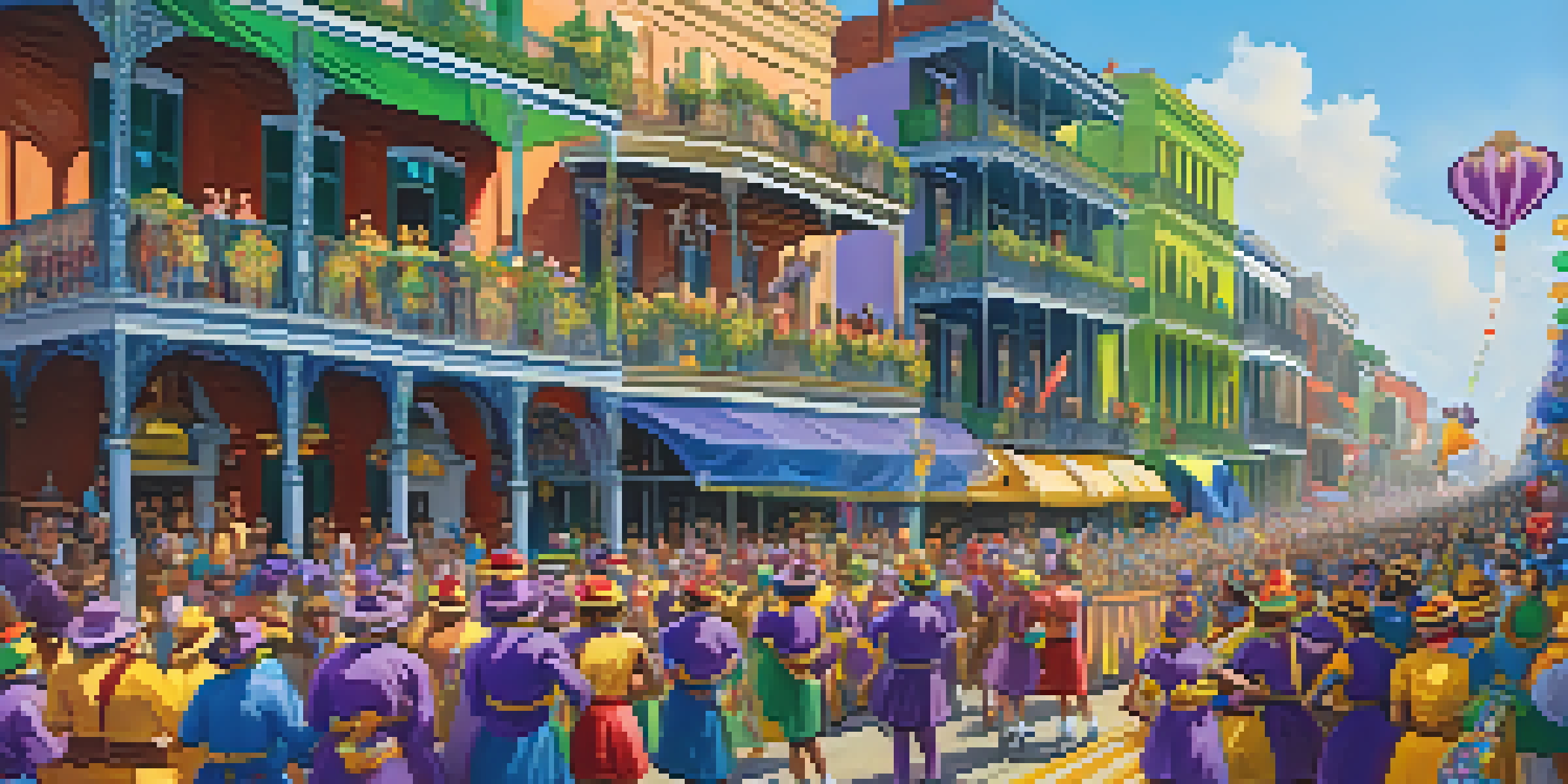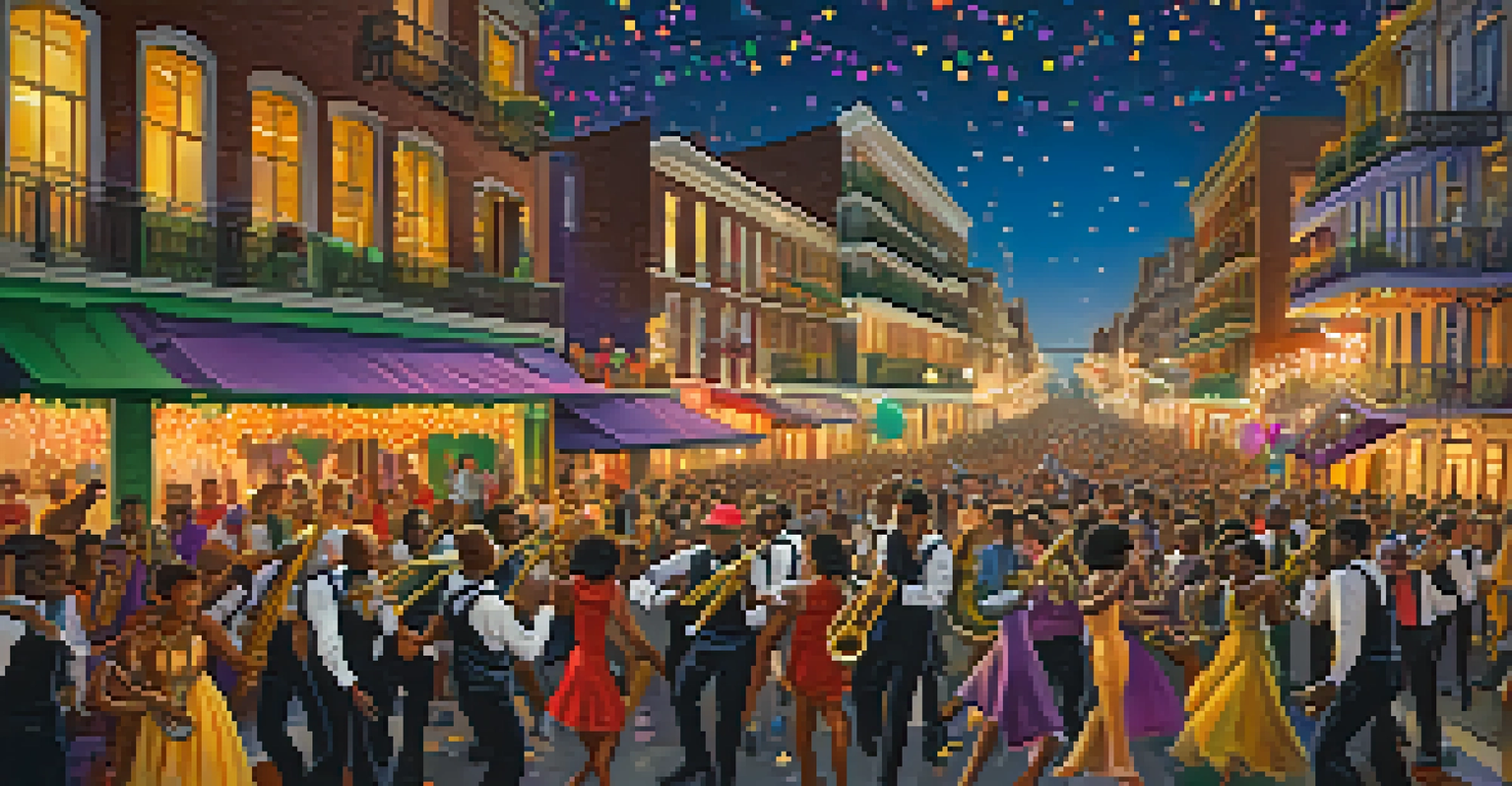The Spectacle of Mardi Gras Parades: A Cultural Overview

The Historical Roots of Mardi Gras Celebrations
Mardi Gras, or 'Fat Tuesday,' has deep historical roots that trace back to ancient pagan festivals celebrating the arrival of spring. In the Christian tradition, it marks the day before Ash Wednesday, the beginning of Lent, a period of fasting and reflection. The celebration evolved over centuries, influenced by both European traditions and local customs, particularly in New Orleans, where it became a vibrant spectacle.
Mardi Gras is not just a celebration; it's a vibrant expression of community and culture.
The first documented Mardi Gras celebration in America occurred in 1837, setting the stage for what would become an iconic annual event. Over time, the parades grew more elaborate, showcasing a blend of French, Spanish, and African cultural influences. This unique mix has created a rich tapestry of traditions that continue to evolve, making Mardi Gras a symbol of cultural resilience and joy.
Today, Mardi Gras parades are not just about revelry; they reflect the spirit of a community that embraces diversity and creativity. Each float, costume, and bead thrown into the crowd tells a story that connects generations, preserving the history while inviting newcomers to join in the festivities.
The Colorful Symbols of Mardi Gras Parades
Mardi Gras is renowned for its vibrant colors, particularly purple, green, and gold, each symbolizing unique attributes: justice, faith, and power, respectively. These colors are not just decorative; they carry significant meaning and are prominently displayed on costumes, floats, and decorations throughout the parades. The visual spectacle captivates participants and viewers alike, enhancing the festive atmosphere.

Additionally, the iconic masks worn during the parades serve as a symbol of mystery and freedom, allowing wearers to shed their everyday identities. This tradition of masking dates back to the early days of Mardi Gras, where anonymity encouraged revelry without social constraints. It fosters a sense of unity among participants, as everyone becomes part of the celebration, regardless of background.
Mardi Gras: A Cultural Celebration
Mardi Gras is a vibrant festival that blends historical traditions, community spirit, and creative expression, particularly in New Orleans.
Moreover, the throws—beads, coins, and trinkets tossed from floats—are not merely souvenirs; they symbolize generosity and the spirit of sharing. Catching these tokens is part of the fun, creating a tangible connection between the parade participants and the crowd, making everyone feel involved in the celebration.
The Role of Krewes in Mardi Gras Parades
Krewes are social organizations that play a central role in organizing Mardi Gras parades. Each krewe has its own unique theme, traditions, and history, often dating back many years. Members invest time and creativity into crafting their floats and costumes, making each parade a collaborative effort that showcases their individual flair while contributing to the larger celebration.
The beauty of Mardi Gras lies in its ability to blend tradition with innovation, ensuring its relevance in modern times.
These krewes often host balls and other events throughout the carnival season, fostering a sense of community and camaraderie among their members. This aspect of Mardi Gras highlights how the event is as much about social connection as it is about the parade itself. It’s a time for friends and families to come together, celebrate, and create lasting memories.
Additionally, many krewes engage in philanthropic efforts, giving back to the community through various charitable initiatives. This blend of festivity and responsibility underscores the importance of Mardi Gras as a celebration that not only entertains but also uplifts and supports the local community.
The Music and Dance of Mardi Gras Celebrations
Music is the heartbeat of Mardi Gras, with lively jazz, zydeco, and brass bands filling the air with infectious rhythms. The soundscape blends traditional New Orleans jazz with contemporary tunes, creating an atmosphere that encourages dancing and celebration. Each parade is a unique performance, where musicians and dancers come together to uplift the crowd, making the experience unforgettable.
Street performers and local artists enhance the festive vibe, adding an exciting element to the parades. The spontaneous dance parties that break out among spectators are a testament to the joy and freedom that Mardi Gras embodies. People of all ages join in the fun, breaking down barriers and celebrating life through music and movement.
Significance of Krewes
Krewes play a central role in organizing Mardi Gras parades, fostering community connections and showcasing diverse themes and charitable efforts.
Moreover, the incorporation of cultural dances from diverse communities enriches the festivities, showcasing the melting pot that is New Orleans. This inclusivity not only honors the city’s heritage but also invites everyone to participate in the joyous expression of culture, making Mardi Gras a truly communal experience.
The Culinary Delights of Mardi Gras
No Mardi Gras celebration is complete without indulging in the culinary delights that accompany the festivities. Traditional foods like king cake, gumbo, and jambalaya play a significant role in the overall experience. Each dish carries its own story, often linked to the cultural influences that have shaped New Orleans cuisine over centuries.
King cake, a sweet pastry adorned with the iconic Mardi Gras colors, is a must-have treat during the season. Hidden within the cake is a small figurine, and the person who finds it is crowned king or queen for the day, embodying the playful spirit of the celebration. Sharing food during Mardi Gras fosters a sense of community, as friends and families gather to enjoy these special dishes together.
Street vendors and local restaurants also offer a wide array of food options, making it easy for parade-goers to fuel their festivities. This culinary aspect transforms Mardi Gras into a feast for the senses, where the flavors of New Orleans come alive, further enriching the cultural tapestry of the celebration.
The Significance of Mardi Gras to Local Communities
Mardi Gras is more than just a party; it holds significant cultural importance for local communities. It serves as an opportunity for residents to come together, celebrate their heritage, and showcase their creativity. The parades and festivities strengthen community bonds, allowing people to reconnect and renew their sense of belonging.
Moreover, the economic impact of Mardi Gras cannot be overlooked. The influx of tourists boosts local businesses, from hotels to restaurants, providing a vital source of income for many. This economic support helps sustain the local culture, ensuring that the rich traditions of Mardi Gras can continue for future generations.
Culinary Delights Enhance Festivities
The culinary offerings of Mardi Gras, including king cake and gumbo, enrich the celebration and bring people together through shared food experiences.
Additionally, the event provides a platform for local artists, musicians, and performers to showcase their talents. Mardi Gras celebrates and elevates the voices of the community, allowing them to share their stories and creativity with a broader audience, further enriching the cultural landscape.
The Evolution of Mardi Gras in Modern Times
As society evolves, so too does Mardi Gras, adapting to contemporary issues while maintaining its core traditions. Recent years have seen an increase in efforts to make the celebration more inclusive and environmentally friendly. This evolution reflects a growing awareness of social and environmental responsibility within the festivities.
For instance, many krewes are now incorporating sustainable practices into their parades, such as using eco-friendly materials for floats and reducing waste. This shift not only preserves the joyous spirit of Mardi Gras but also demonstrates a commitment to protecting the beautiful city of New Orleans for future generations.

Additionally, the impact of technology on Mardi Gras is noteworthy, with social media playing a significant role in promoting events and connecting participants. This modern twist allows for broader engagement, encouraging people from all walks of life to join the celebration, while still honoring the rich traditions that make Mardi Gras so special.